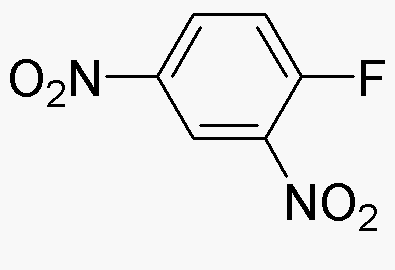2,4-Dinitrofluorobenzene is widely utilized in research focused on:
- Organic Synthesis: This compound serves as a key intermediate in the synthesis of various organic compounds, particularly in the production of pharmaceuticals and agrochemicals.
- Analytical Chemistry: It is employed as a reagent for the detection and quantification of amino acids and proteins, enhancing the accuracy of analytical methods.
- Material Science: The compound is used in the development of polymer materials, where it acts as a cross-linking agent, improving the mechanical properties of the final products.
- Biochemistry: In biochemical research, it is utilized for labeling biomolecules, aiding in the study of protein interactions and cellular processes.
- Environmental Science: It plays a role in the assessment of environmental pollutants, helping researchers to understand the behavior and degradation of nitroaromatic compounds in ecosystems.
General Information
Properties
Safety and Regulations
Applications
2,4-Dinitrofluorobenzene is widely utilized in research focused on:
- Organic Synthesis: This compound serves as a key intermediate in the synthesis of various organic compounds, particularly in the production of pharmaceuticals and agrochemicals.
- Analytical Chemistry: It is employed as a reagent for the detection and quantification of amino acids and proteins, enhancing the accuracy of analytical methods.
- Material Science: The compound is used in the development of polymer materials, where it acts as a cross-linking agent, improving the mechanical properties of the final products.
- Biochemistry: In biochemical research, it is utilized for labeling biomolecules, aiding in the study of protein interactions and cellular processes.
- Environmental Science: It plays a role in the assessment of environmental pollutants, helping researchers to understand the behavior and degradation of nitroaromatic compounds in ecosystems.
Documents
Safety Data Sheets (SDS)
The SDS provides comprehensive safety information on handling, storage, and disposal of the product.
Product Specification (PS)
The PS provides a comprehensive breakdown of the product’s properties, including chemical composition, physical state, purity, and storage requirements. It also details acceptable quality ranges and the product's intended applications.
Certificates of Analysis (COA)
Search for Certificates of Analysis (COA) by entering the products Lot Number. Lot and Batch Numbers can be found on a product’s label following the words ‘Lot’ or ‘Batch’.
*Catalog Number
*Lot Number
Certificates Of Origin (COO)
This COO confirms the country where the product was manufactured, and also details the materials and components used in it and whether it is derived from natural, synthetic, or other specific sources. This certificate may be required for customs, trade, and regulatory compliance.
*Catalog Number
*Lot Number
Safety Data Sheets (SDS)
The SDS provides comprehensive safety information on handling, storage, and disposal of the product.
DownloadProduct Specification (PS)
The PS provides a comprehensive breakdown of the product’s properties, including chemical composition, physical state, purity, and storage requirements. It also details acceptable quality ranges and the product's intended applications.
DownloadCertificates of Analysis (COA)
Search for Certificates of Analysis (COA) by entering the products Lot Number. Lot and Batch Numbers can be found on a product’s label following the words ‘Lot’ or ‘Batch’.
*Catalog Number
*Lot Number
Certificates Of Origin (COO)
This COO confirms the country where the product was manufactured, and also details the materials and components used in it and whether it is derived from natural, synthetic, or other specific sources. This certificate may be required for customs, trade, and regulatory compliance.


